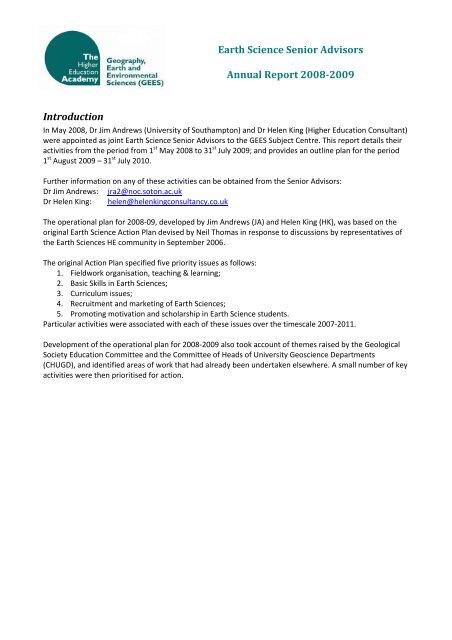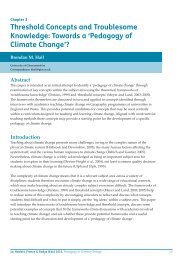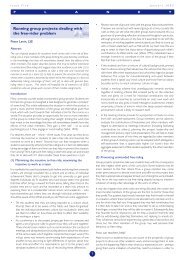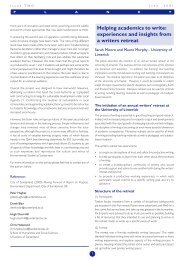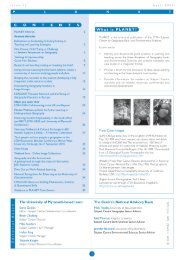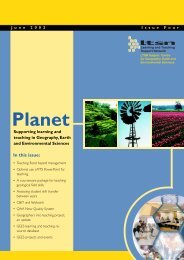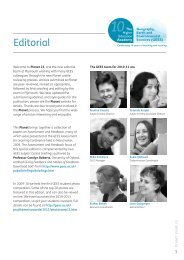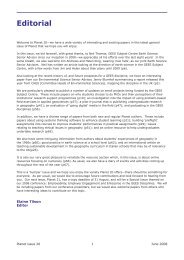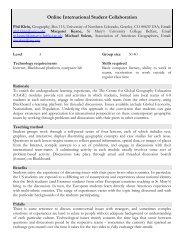GEES Subject Centre Home
GEES Subject Centre Home
GEES Subject Centre Home
Create successful ePaper yourself
Turn your PDF publications into a flip-book with our unique Google optimized e-Paper software.
Earth Science Senior Advisors<br />
Annual Report 20082009<br />
Introduction<br />
In May 2008, Dr Jim Andrews (University of Southampton) and Dr Helen King (Higher Education Consultant)<br />
were appointed as joint Earth Science Senior Advisors to the <strong>GEES</strong> <strong>Subject</strong> <strong>Centre</strong>. This report details their<br />
activities from the period from 1 st May 2008 to 31 st July 2009; and provides an outline plan for the period<br />
1 st August 2009 – 31 st July 2010.<br />
Further information on any of these activities can be obtained from the Senior Advisors:<br />
Dr Jim Andrews: jra2@noc.soton.ac.uk<br />
Dr Helen King: helen@helenkingconsultancy.co.uk<br />
The operational plan for 2008‐09, developed by Jim Andrews (JA) and Helen King (HK), was based on the<br />
original Earth Science Action Plan devised by Neil Thomas in response to discussions by representatives of<br />
the Earth Sciences HE community in September 2006.<br />
The original Action Plan specified five priority issues as follows:<br />
1. Fieldwork organisation, teaching & learning;<br />
2. Basic Skills in Earth Sciences;<br />
3. Curriculum issues;<br />
4. Recruitment and marketing of Earth Sciences;<br />
5. Promoting motivation and scholarship in Earth Science students.<br />
Particular activities were associated with each of these issues over the timescale 2007‐2011.<br />
Development of the operational plan for 2008‐2009 also took account of themes raised by the Geological<br />
Society Education Committee and the Committee of Heads of University Geoscience Departments<br />
(CHUGD), and identified areas of work that had already been undertaken elsewhere. A small number of key<br />
activities were then prioritised for action.
1: Fieldwork Organisation, Teaching & Learning<br />
1.1: Priority Activity: Running a field skills residential course for staff without the<br />
requisite background experience.<br />
This idea was discussed by the Geological Society Education Committee and it was agreed that the week<br />
long course run by the British Geological Survey (BGS) should be used as the basis for the activity. Colin<br />
Waters of the BGS ran the course, including registering participants and managing logistics. Additional<br />
advice and input regarding issues such as teaching in the field was provided by JA. The specification for the<br />
course was developed in discussion with the Geological Society Education Committee and the programme<br />
and budget then negotiated with the BGS. The event was piloted with 8 participants and the cost<br />
subsidised by the <strong>GEES</strong> <strong>Subject</strong> <strong>Centre</strong> (from the Earth Science Senior Advisor budget) and the BGS.<br />
The event was advertised to Earth Science departments across the UK and generated a reasonable amount<br />
of interest. 9 people formally registered from which 8 were selected to attend. A number of other<br />
departments expressed an interest in the event but did not nominate any participants. The event took<br />
place from 23 rd to 27 th March. It was based in Chesterfield and involved one day’s training at Curbar Edge in<br />
the Peak District followed by four days mapping in Grave’s Park, Sheffield. Formal presentations, exercises<br />
and time for inking‐in were provided at the hotel accommodation in the evenings.<br />
The training mostly focused on feature mapping of dipping beds of sandstone and mudstone. There was<br />
little exposure, though participants had the opportunity to undertake some section logging at a couple of<br />
localities. Colin Waters (BGS) provided the majority of mapping training and the benefit of his expertise and<br />
experience in the field areas. Jim Andrews supplemented his advice and guidance and provided additional<br />
information on teaching in the field. The tutoring was perceived as excellent by all the participants, e.g.:<br />
The tutor‐tutee relationship was excellent. There were plenty of opportunities for questions and<br />
discussion, which was good. There was also lots of learning by example in the field and time to<br />
discuss what was being seen.<br />
The course had a good balance of group and individual tasks which enabled me to learn from others<br />
and discuss my observations and thoughts. I liked the different inputs the tutors had to the course<br />
and their expertise in both mapping and teaching geological field skills made the course interesting<br />
and diverse.<br />
Curbar Edge, Peak District<br />
Grave’s Park, Sheffield
The participants’ background was varied, some were geoscientists but had not undertaken detailed<br />
mapping, others were non‐geoscientists including physics and biology. The course was received extremely<br />
positively by the majority of participants, for example:<br />
The course content was at the correct level for non‐geologists and the geology terms were explained<br />
very well. The practical exercises allowed us to work as a group as well as to think at our own pace. I<br />
enjoyed the evening sessions where I could use all the observations I had made during the field tasks to<br />
understand the geology of the area.<br />
I now am confident I could do a much better job when helping to teach students and in fact can<br />
probably use an abney level better than most of the Lecturers! I was also very pleased with the way my<br />
map was developing, it was not perfect or finished but I think it was really coming together.<br />
The only criticisms were regarding the late nights and the lack of exposure / variation of lithology. Some<br />
participants weren’t sure whether the feature mapping would be used on field trips with students:<br />
It might have been useful to have had an extra day at the start to cover all the theory/presentations<br />
etc, so that during the week we could concentrate on the mapping tasks. I found it hard to<br />
concentrate after 9pm or so, which was frustrating because the presentations that Colin gave were<br />
crucial for our understanding of the field mapping.<br />
How relevant is this to the sort of fieldwork you’ll be doing with students? Pretty good, we don’t<br />
tend to do a lot of the ... feature mapping rather than actually looking at rocks, I mean our second<br />
years we take out to Spain they’ve got complete exposure really, so don’t do a lot of feature<br />
mapping but I’m sure it can help wouldn’t hurt.<br />
These were seen as very minor issues by the participants and they understood that the long days were<br />
required to fit in all the work. Several participants expressed an interest in a follow‐up course:<br />
I would be interested in a follow‐up course if the course examined a different lithology such as igneous<br />
or metamorphic rocks. I have recently returned from helping to teach a first year fieldtrip and was<br />
confident with most of the trip apart from practical exercises looking at igneous rock<br />
exposures.[Comments sent after course and on return from a field trip with students]<br />
Only one participant (a non‐geoscientist) did not have such a good experience and they chose to leave the<br />
course at the end of day two. They supplied thorough feedback, explaining the ways in which the course<br />
did not meet their expectations. In summary:<br />
• It was more physically demanding than anticipated<br />
• It assumed more prior experience of using maps than I had<br />
• It focused strongly on detailed geological surveying rather than the basic field techniques I need<br />
to be able to teach to undergraduates.<br />
Conclusion<br />
The field course was a great success and proved to be a positive experience for the majority of participants.<br />
In general the course provided an appropriate level of mapping training, though more exposures and a<br />
greater variety of lithology may have made it more relevant to the type of localities that students tend to<br />
be taken to. A few participants expressed the ‘value for money’ of the course (they only paid<br />
accommodation and travel expenses); whether departments would be willing to pay the full cost of a BGSrun<br />
course remains to be seen.<br />
The Earth Science Senior Advisors recommend that a second course be run in the Autumn of 2010 using<br />
academic staff as the main tutors in a locality frequented by UK departments (e.g. Ingleton). Participants<br />
from the first course could be invited back both as a follow‐up and to act as peer‐mentors to new<br />
colleagues.<br />
We would like to express our sincere thanks to Colin Waters and the BGS for supporting this pilot course<br />
and providing an excellent week of mapping training.
1.2: Additional Activity: the information collected by JA on field locations and their<br />
uses will be published on the <strong>GEES</strong> wiki by HK.<br />
This information has been published on the <strong>GEES</strong> <strong>Subject</strong> <strong>Centre</strong> website (within the Earth Science pages)<br />
at http://www.gees.ac.uk/home/earthresources.htm#fieldlocs<br />
If any department wishes to update their entry, please email helen@helenkingconsultancy.co.uk<br />
1.3: Additional Activity: Thin Section Preparation Course<br />
Following the <strong>Subject</strong> <strong>Centre</strong>’s last ‘Supporting the Supporters’ event, Norman Morris from the University<br />
of Glamorgan offered to run a course on thin section preparation. JA corresponded with Norman and it was<br />
agreed that the course would be subsidised from the Senior Advisor budget to a maximum of £1500. The<br />
course ran from 9‐11 th September at the University of Glamorgan, though JA & HK felt that this was too<br />
soon to allow for adequate publicity. Information on the course was included in the <strong>GEES</strong> jiscmail and<br />
website. Only one participant registered for the course which went ahead anyway. Norman Morris<br />
requested support for evaluation, advice was provided by HK. The evaluation outcome has not been shared<br />
with the senior advisors as yet.<br />
2: Basic Skills in Earth Sciences<br />
2.1: Collation of Resources on Teaching Quantitative Skills<br />
Numeric skills requirements for the Earth Sciences have been specified by the Geological Society as part of<br />
their accreditation scheme. A large number of resources on numeric skills are available on the Internet<br />
from UK and international sources. Information on these resources has been collated and made available<br />
by via the <strong>GEES</strong> <strong>Subject</strong> <strong>Centre</strong> website at http://www.gees.ac.uk/home/earthskills.htm
3: Curriculum Issues<br />
3.1: Employer Engagement Survey<br />
Discussion with the <strong>GEES</strong> <strong>Subject</strong> <strong>Centre</strong> Director and Manager indicated that employer engagement and<br />
the outcomes of the Leitch report were items to be prioritised under this theme (as indicated by the<br />
funding councils and the HE Academy). It was suggested that the Earth Sciences may already be very active<br />
with respect to employer engagement and that a useful activity would be to investigate the current state of<br />
play. A ‘state of play’ / baseline audit into the role of employer engagement was conducted as part of a<br />
wider project with Environmental Sciences funded by the HE Academy. A summary of the project was<br />
published by Sharon Gedye in the January 2009 edition of ‘Planet’ and can be downloaded from the <strong>GEES</strong><br />
website at http://gees.ac.uk/pubs/planet/p21/sg.pdf<br />
Earth Science Summary<br />
This exercise was conducted as a series of telephone interviews with colleagues from ten Earth Science<br />
departments in English higher education institutions. Most interviewees were not familiar with the specific<br />
term ‘employer engagement’ but all suggested that it meant something along the lines of:<br />
...a two‐way flow of information between us and employers to ensure that the appropriate<br />
knowledge and skills are developed to prepare students for employment.<br />
All the interviewees expressed a strong sense of the rationale for employer engagement being about<br />
benefiting (undergraduate or postgraduate) students within the department; rather than for the direct<br />
benefit of the employer in terms of workforce development. Many departments noted that the high<br />
demand for geology graduates (particularly in the petroleum and mining industries) is such that employers<br />
are very keen to engage with HEIs in order to recruit.<br />
In general terms, liaison with employers was seen as very important by 9 out of 10 of the interviewees and<br />
the tenth suggested that, although it wasn’t currently important they suspected that it would become more<br />
so. The importance of links with employers was expressed in two ways, firstly as a way of ensuring the<br />
relevance of the curriculum and supporting the employability of graduates; and secondly, as a way of<br />
illustrating to students the relevance of geology to their everyday lives. The workforce development aspect<br />
of employer engagement was not considered a priority by any of the interviewees.<br />
There did not appear to be any systematic difference in approach to employer engagement between old<br />
and new universities. Rather the differences appear to arise mainly as a result of the historical relationships<br />
departments have had with employers. Those that were involved in a considerable number of activities had<br />
done so for a long time either through links with research, a long‐term commitment to employability or<br />
through the vocational nature of the degree courses. It should be noted that many Earth Science MSc<br />
courses are highly vocational and serve direct employment needs.<br />
It is my impression (though this needs to be researched further to be verified) that the large multi‐national<br />
companies (particularly in the petroleum and mining industries) have the scope to provide their own inhouse<br />
training. SMEs, public sector organisations and consultancy‐type businesses are more likely to takeup<br />
external training opportunities; however, the demand is not big enough to provide an economic<br />
incentive for HEIs to provide courses. As the list of training providers on the Geological Society website<br />
indicates, most CPD / workforce development provision comes from smaller, independent consultancies.<br />
HEI provision includes both academics going out to industry and employees coming in to the HEI to<br />
participate in undergraduate or postgraduate modules and degrees.<br />
The most commonly quoted barrier to employer engagement was staff time; this agenda is hard to<br />
prioritise against research, teaching, administration and other demands on time. The two departments for<br />
whom there were no barriers noted that working with employers was part of the departmental /<br />
institutional culture due to the historical linkages with industry.
None of the interviewees felt that any support was required from organisations such as the <strong>GEES</strong> <strong>Subject</strong><br />
<strong>Centre</strong>. Liaising with employers, including for workforce development, was seen as a departmental /<br />
institutional issue.<br />
The full report from the Earth Sciences is available to download from the Earth Science pages of the <strong>GEES</strong><br />
<strong>Subject</strong> <strong>Centre</strong> website at http://www.gees.ac.uk/home/discearth.htm<br />
3.2: Research into Students’ ‘Sticking Points’ in Learning Geoscience<br />
This project aims to pump‐prime research which will then form a strong foundation on which to build (and<br />
seek funding for) a larger‐scale, internationally collaborative project. The outcomes will be threefold:<br />
• A literature review of troublesome concepts in the geosciences;<br />
• Research papers (for Planet and the Journal of Geoscience Education) describing the methodology,<br />
findings and conclusions / recommendations arising from the research;<br />
• The development of an international research group on Threshold Concepts in the geosciences<br />
(interest has already been expressed by colleagues in the UK, USA, Canada, Ireland and South<br />
Africa).<br />
The research is being undertaken by HK. An online survey and face‐to‐face interviews were conducted with<br />
geoscience staff and students at the University of Plymouth (March 09), the University of Calgary and the<br />
University of Colorado at Boulder (February 09). The data is currently being collated and analysed. The<br />
results of the research are to be presented at the GSA annual meeting in October 2009. HK has had an<br />
abstract proposal accepted for a special publication of the GSA on qualitative research and will also write<br />
up the project for the Journal of Geoscience Education. A summary paper will also be written for Planet.
4: Recruitment and Marketing of Earth Sciences<br />
4.1: Priority Activity: conducting a review of outreach / recruitment activities in<br />
order to identify and promote effective models.<br />
Student recruitment is a key issue for many Earth Science departments in UK higher education. A variety of<br />
strategies are employed to attract students both to the discipline and to individual institutions. In order to<br />
support this work the Earth Science Senior Advisors undertook a survey to identify and promote effective<br />
models of practice. All departmental contacts and heads of department were made aware of survey and it<br />
was also advertised via the Earth Science email newsletter and web page on the <strong>GEES</strong> <strong>Subject</strong> <strong>Centre</strong><br />
website. The survey was made available to complete online through the ‘Bristol Online Survey’ tool. 16<br />
responses were received from 15 departments out of a possible 39 members of Committee of Heads of<br />
University Geoscience Department (CHUGD: http://www.chugd.ac.uk/institutions.php) (38.5% response<br />
rate).<br />
Summary<br />
Respondents were asked to outline what they thought was their department’s most effective strategy for<br />
promoting Earth Sciences to potential students. The most common responses involved potential students<br />
visiting the department and the department interacting with schools. Respondents were asked to select<br />
from a list which recruitment / outreach activities their department undertakes. The whole range of<br />
options were selected across all the departments responding, the most popular were staff giving talks to<br />
schools (9 departments) and staff contributing to careers events in schools (8 departments).<br />
The Senior Advisors were interested to know which resources were being used by the Earth Science HE<br />
community. Four departments are involved with the BGS Schools Seismology project but most<br />
departments use their own resources. 8 departments stated that they were involved in Ambassador‐type<br />
outreach schemes, the most popular (6 departments) being the Undergraduate Ambassador Scheme.<br />
Respondents were asked whether they thought a more collaborative approach would boost interest in the<br />
Earth Sciences in the UK and, if so, what activities they thought might be effective. The overall response<br />
was strongly in favour of the need for a collaborative / centrally‐organised approach to support an<br />
increased awareness of the Earth Sciences in general.<br />
Three respondents provided additional comments, two of these suggested ideas for general awareness<br />
raising for the Earth Sciences. The third noted that the Scottish system of higher education provided an<br />
opportunity for Earth Science departments to ‘recruit’ students during level one, as they state “Enabling<br />
this transition from ES as one of 3 first‐year subjects through to Honours is an important advantage of [the<br />
Scottish] system.”<br />
The full report has been posted on the <strong>GEES</strong> <strong>Subject</strong> <strong>Centre</strong> website. In addition to the analysis of<br />
departmental responses, mini case studies were obtained from 7 departments on a variety of recruitment<br />
approaches.<br />
4.2: Additional Activity: Evaluation of the Undergraduate Ambassadors Scheme<br />
Sending undergraduates/recent graduates into schools has become increasingly recognised as an important<br />
mechanism encouraging wider participation in further and higher education, particularly in strategically<br />
important science, technology, engineering and mathematics (STEM) disciplines. At the same time those<br />
participating benefit from exposure to the environment of primary and secondary education, enhancing<br />
their soft skills. There are an increasing number of schemes run under a number of banners with a variety
of stakeholders. Foremost of these are the National Undergraduate Ambassadors Scheme (UAS 2008a) and<br />
the Student Associates Scheme.<br />
At a discipline level, the Royal Geographical Society has piloted an ambassadors scheme for the past 3 years<br />
and is now rolling this out nationally. The scheme recruits, trains and supports geographers currently at<br />
university and graduate geographers from the work place to act as ambassadors for geography in the<br />
classroom.<br />
Recruitment to the <strong>GEES</strong> disciplines, particularly Earth sciences and environmental sciences and latterly<br />
Geography has come under pressure for a variety of reasons. Amongst these are the establishment of a<br />
National Curriculum in which earth and environmental sciences are embedded in other subject areas e.g.<br />
physics, chemistry and biology and the downgrading of geography as a core subject. Ambassadors schemes<br />
are viewed as a means of bringing geography, but particularly earth and environmental sciences into the<br />
classroom as specific disciplines which students may go on to study at university. There is currently little<br />
hard evidence available to judge how effective these schemes might be in this context or indeed in the<br />
wider context of the overall aims of the individual schemes.<br />
The Earth Science Senior Advisors, with assistance from Joy Maloney (Faculty of Science Learning &<br />
Teaching Co‐ordinator, University of Southampton) are conducting a small‐scale, pilot research project to<br />
investigate the impact of the UAS scheme on participating <strong>GEES</strong> students and the pupils and teachers in<br />
their placement schools. Students from the Universities of Southampton, Leeds and Durham are taking part<br />
by sharing their UAS evaluation forms and administering a short questionnaire to the pupils at their<br />
placement schools. This research is currently in progress; a full report will be available for the November<br />
2009 CHUGD meeting.
5. Promoting Motivation and Scholarship in Earth Science students<br />
Following the foundation work undertaken on the above themes and in developing the network in 2008‐09,<br />
this theme will be taken forward as a priority in 2009‐2010.<br />
Other Activities<br />
In addition to the specific themes identified above, the following administrative activities were also<br />
undertaken:<br />
• Identification of department contacts and learning & teaching champions;<br />
o The list of departmental contacts has been augmented with known ‘champions’ and any<br />
Earth Scientists who attended an event, wrote for Planet or received small‐scale project<br />
funding since May 2000. The list will be maintained by HK and updated on a regular basis<br />
through correspondence with HoDs and the contacts themselves.<br />
• Development of up‐to‐date content for the <strong>GEES</strong> <strong>Subject</strong> <strong>Centre</strong> and Geological Society websites (in<br />
collaboration with Mike Sanders and Jo Mears respectively):<br />
o HK has been given editing rights to both the <strong>GEES</strong> <strong>Subject</strong> <strong>Centre</strong> website and the<br />
education pages of the Geol Soc website. Details of Earth Science learning and teaching<br />
activities will be posted on the <strong>GEES</strong> site with links from the Geol Soc.<br />
• Dissemination of a regular newsletter to contacts, champions and heads of department (to include<br />
information on specific Earth Science and relevant <strong>GEES</strong> and broader HE issues, resources and<br />
activities);<br />
o Two newsletters have been distributed to the email list to date and a third will be<br />
circulated in mid‐May.<br />
• Attendance at relevant meetings and events.<br />
o Geological Society Education Committee, May & Sept 2008 (JA)<br />
o Departmental visit to the University of Manchester, May 2008 (JA)<br />
o National Academies Board on Science Education national workshop on STEM education<br />
research, June 2008 (HK). HK was asked to present overview of geoscience education<br />
research in the US (http://www7.nationalacademies.org/bose/HelenKing_Report.pdf).<br />
Other disciplines giving presentations were physics and chemistry. Geoscience education<br />
research is still relatively new compared to the other disciplines and has many, exciting<br />
avenues to explore.<br />
o ESTA Conference, Sept 2008 (JA). Good contacts were made particularly with respect to the<br />
recruitment project.<br />
o As CPD, HK joined the University of Derby’s Geohazard two week fieldtrip to the pacific<br />
northwest. As well as helping to revise her geological knowledge and visit some excellent<br />
sites, the trip provided the opportunity for ‘sitting in’ on the 3rd year students’ experience.<br />
o GSA Annual Meeting, Oct 2008 (HK). She gave an oral presentation, chaired a session on<br />
Geocognition and presented a poster (jointly badged with <strong>GEES</strong> and the University of<br />
Plymouth) on researching threshold concepts in geoscience to raise awareness of the<br />
‘sticking points’ research project.<br />
o National Academies Board on Science Education national workshop on STEM education<br />
research, Oct 2008 (HK). Although not offering a formal presentation she did have the<br />
opportunity to promote the work of the HE Academy with respect to discipline‐based<br />
faculty development. The workshop convenors subsequently asked HK to write to STEM<br />
<strong>Subject</strong> <strong>Centre</strong>s inviting them to join the project listserve.<br />
o OPITO meeting, Oct 2008 (JA)<br />
o In November, HK attended an ‘On the Cutting Edge’ workshop on metacognition in the<br />
Geosciences. As well as gathering some interesting examples of practice, some good
o<br />
contacts were made and considerable interest obtained for future research in the area of<br />
threshold concepts / nature of geoscience.<br />
With the above meetings (including attendance at the geoscience educator’s reception and<br />
geocognition / geoscience education research meeting at GSA, HK has built on her existing<br />
network of contacts in the US. Amongst other benefits, this resulted in two colleagues (one<br />
from the US and one from Canada) offering to provide staff and student participants for the<br />
‘sticking points’ research project thus adding an international dimension to the work.<br />
• Supporting the central <strong>GEES</strong> <strong>Subject</strong> <strong>Centre</strong> activities as appropriate.<br />
o <strong>GEES</strong> <strong>Subject</strong> <strong>Centre</strong> advisory board, May 2008 (JA)<br />
o <strong>GEES</strong> <strong>Subject</strong> <strong>Centre</strong> conference on employability, July 2008 (JA)<br />
o <strong>GEES</strong> <strong>Subject</strong> <strong>Centre</strong> interview panel for dissemination co‐ordinator, Nov 2008 (JA)<br />
o <strong>GEES</strong> <strong>Subject</strong> <strong>Centre</strong> team away day, March 2009 (HK & JA)<br />
o <strong>GEES</strong> <strong>Subject</strong> <strong>Centre</strong> interview panel for Director, May 2009 (JA)<br />
o Reviewing proposals for small‐scale projects & student essay competition (JA & HK)<br />
o Reviewing Maskall & Stokes’ fieldwork guide for the environmental and natural sciences (JA<br />
& HK)<br />
o JA liaised with the Earth Science community and Mike Sanders to provide input to the<br />
successful bid from the <strong>GEES</strong> <strong>Subject</strong> <strong>Centre</strong> to the JISC Open Educational Resources (OER)<br />
fund.<br />
o HK has contacted Cogent (the Sector Skills Council for Chemicals, Pharmaceuticals, Nuclear,<br />
Oil & Gas, Petroleum & Polymers) and arrangements are underway to meet and discuss<br />
common issues.


